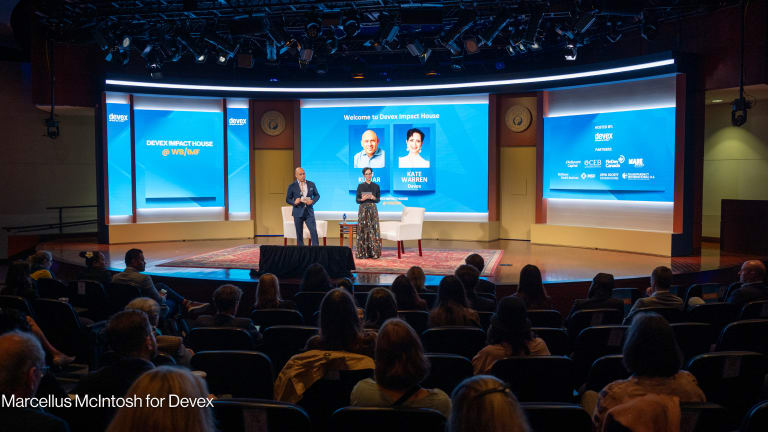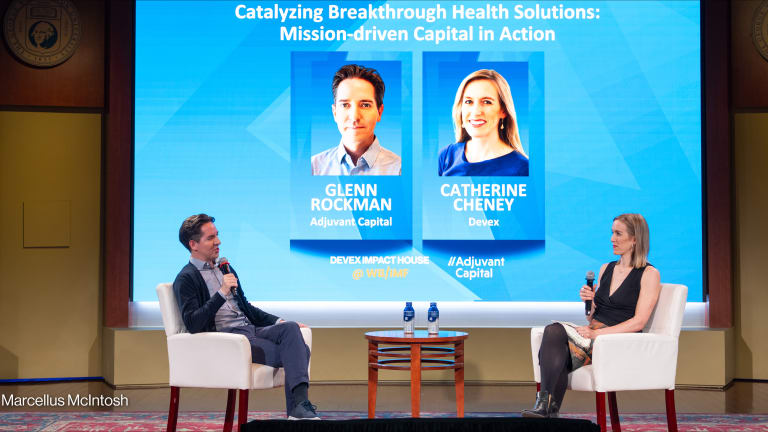
SANTA CLARA, Calif. — Before he co-founded a for-profit company that distributes clean water from off-grid treatment centers to independent retail shops in developing countries, Dan Nolan ran a nonprofit in Haiti, which he described as “the classic NGO thing.” The money came in, the organization built water treatment centers, they celebrated the openings and took pictures with community members — and all too often, after the projects ended, the facilities fell into disrepair.
Nolan’s frustration with that cycle was one of the factors that led him to join Jim Chu, the founder and chief executive officer of Untapped — formerly dloHaiti — to create a for-profit model to provide water and sanitation. One of their goals was to move away from a system where grant-based funding seemed to create barriers for sustainability. Nolan and Chu explain that their solution designed for the 1.1 billion people in sprawling urban regions equates to an annual $678 million market.
“We are wary of the risk of grants distorting the incentives of our business. We don't want to depend on grants in order to have a sustainable operation. We see this far too often in the NGO world and it's a constant slippery slope for social enterprises,” Chu said.
Last week, Nolan pitched to a room of investors. He explained how dloHaiti reached profitability, how a private equity fund in Haiti purchased a majority share of the company, and how Untapped expanded into four new countries in the first 6 months of 2018. Then he asked for $1 million in equity and grants and $2 million in collateralized debt, taking his mentors’ advice, who suggested that he take what he can get in order to support different goals for the business.
Grant funding has typically been the domain of nonprofit social enterprises and NGOs, but a growing number of for-profit social enterprises are looking to grants when commercial funding falls short.
Certain activities may have a clear path to impact but not as clear a path to profit. For-profit social enterprises will seek a combination of equity and debt funding as well as philanthropic support or grants in cases where the intervention is unproven or high risk, or the returns are longer term or unquantifiable. Organizations looking to scale their impact, and particularly those serving hard-to-reach populations, need the right capital at the right time for the right activities.
How blended capital can help entrepreneurs make it through the missing middle
Facing a lack of risk capital in their countries, emerging market entrepreneurs are looking to a combination of grants and investments to seed, de-risk, and scale up their startups. Devex explores how blended capital could be the key ingredient to bursting through the "missing middle."
Last week, the Global Social Benefit Institute at Santa Clara University’s Miller Center for Social Entrepreneurship held an investor showcase, where social entrepreneurs pitched investors on their impact, growth plans, and financing needs, and many of them asked for a combination of grants and equity.
“It’s free money!” Ted Levinson, founder and CEO of Beneficial Returns, which offers debt financing to social entrepreneurs in developing countries, said of grant capital in a meeting with Devex following the GSBI investor showcase.
Philanthropic capital is society’s risk capital, Levinson said, explaining that it’s the perfect bucket of money to support the work social enterprises are doing.
“Grants allow people to try new and risky things, to move into more challenging markets, to lower the price of what they’re selling, to ramp up more quickly. It's extraordinarily powerful. There should be no shame in asking for it or giving it,” Levinson said.
Sistema Biobolsa, a Mexico-based GSBI alumni of 2017, enables farmers to turn animal waste into methane gas and organic fertilizer. It is a B corporation, meaning it is a for-profit entity that meets certain standards of using business as a force for good, but that does not mean it will say no to grants.
Ken Lewis, executive director at the Greater Impact Foundation, which funds for-profit social enterprises that focus on poverty eradication, explained how he used a grant to fund Sistema Biobolsa’s expansion into Nicaragua, as it allowed them to gain a foothold in the country without siphoning resources they need to grow the business in more profitable markets such as Mexico and Kenya.
“If you are asking for a grant, explain why you need grant money. Prove to me it’s necessary. I’m more inclined to say you just want my money cause it’s free,” Lewis said.
The GSBI curriculum includes advice on how to make a justifiable ask, which Steve White, an executive fellow and advisory board member with the Miller Center, explained is based on how much, what type, use of funds, and return to investor, which could be economic, or impact, or both.
“Grant capital donations are of critical importance,” he told Devex after the investor showcase.
“In many cases, it is the only type of capital that’s available early on. In my opinion, it should remain a consistent part of their fundraising strategy, until they get all the way to organic cash flow generation,” White said.
“Grants allow people to try new and risky things, to move into more challenging markets, to lower the price of what they’re selling, to ramp up more quickly. It's extraordinarily powerful.
— Ted Levinson, founder and CEO of Beneficial ReturnsFor-profit social enterprises have to make their path to sustainability clear. When Somesh Tewari, the chief operations officer of Sitara, which provides women in India with legal advocacy and financial literacy, took the stage, he asked for $9.5 million in grant funding. That prompted so many investors to shift in their seats that the sound filled the room.
GSBI mentors had advised a working capital line of credit, or some other form of debt that was longer term, but Tewari saw this as the justifiable ask for his organization, and it is ultimately up to the entrepreneurs to come up with the pitch that makes sense for them.
“It is like funding Sudoku,” said Brent Chism, CEO at TaroWorks, an app for managing offline field services, for-profit social enterprise, and part of the 2018 GSBI cohort. “You have to try and figure out what am I doing that is aligned with what this funder is doing that I need to do anyway?”
This year, the GSBI cohort included 11 for-profits, 5 hybrids — a combination of nonprofit and for-profit to scale impact and generate revenue with less of a risk of sacrificing one for the other — and 2 nonprofits.
“Everyone we deal with here, they’re burning cash,” White said. “Even if they’re profitable, their strategic initiatives can put them in a position where they are likely to burn cash for a while, so I think grant capital is critical.”
But as for-profit founders include grant funding as part of their pitch, they are competing with the nonprofits who have long captured those resources, and nonprofit founders point out that one of the challenges they face is competing with for-profits for resources, even though for-profits do not compete with nonprofits for investment.
“In my experience, last mile, base of pyramid work requires philanthropy — only nonprofit social enterprises are successful in these markets,” said Aneri Pradhan, the founder of Enventure, which works in Uganda to finance and train people to launch rural clean energy enterprises.
She acknowledged that for-profits can be well-served by grant funding, but took issue with the fact that too many of them continue receiving these funds long after they've shown profitability.
“I think grants are very helpful though for early stage for-profit innovations that do not yet have a product-market fit,” she continued. “The problem however is that companies who are on their Series B are still taking grants.”
The investor showcase last week marked GSBI’s 16th year. Those who have attended since the beginning say one of the major trends is a growing level of sophistication in the pitches, both with the amount of money the social entrepreneurs ask for, as well as the form of capital they want to see.
“As recently as five years ago, if you said investment, I would say equity,” said Jeff Miller, who spent his career running companies, before donating the money that gave the Miller Center its name.
“If you grow up here, that is what you think of — Silicon Valley startups don’t get any grants, and don’t raise much debt. It’s all about equity. But one of the learnings I have had to go through is understanding that in this business, for most social entrepreneurs, equity is not the right vehicle,” he said.
That is because asking for equity is making a promise that many of these entrepreneurs cannot keep, said Thane Kreiner, the Miller Center’s executive director.
“There are social enterprises that can generate equity-like returns, but it is a thin slice of the social enterprises we need to address the [Sustainable Development Goals],” he said.
Kreiner said it is not always realistic for investors to seek market rate financial returns from social enterprises with a triple bottom line — financial, social, and environmental returns. While some GSBI alumni might fit the model of a traditional venture capital backed company, like Tala, a Los Angeles-based mobile loans company that just closed a $65 million Series C fundraising round, most of the GSBI entrepreneurs are more likely to deliver a return on investment in terms of impact.
Kreiner added that another reason mentors encourage entrepreneurs to ask for grants as well as equity is when for-profit social enterprises become too reliant on equity, the founders might get so diluted they lose control, and can no longer be called a social enterprise.
Kreiner, Miller, and the mentors who work closely with GSBI social entrepreneurs before they take the stage at the investor showcase, advise many of them to put “equity/grants” on their slide deck.
For Chu, there is a positive role for grants in two areas. First, for-profit social entrepreneurs can use them to fund research and development in specific areas — IT tool development and impact studies for example. Second, they can help cover a portion of the up-front capital expenditure needed to serve specific target customers.
“In our case, we see grants playing a role funding the expansion of water infrastructure,” he told Devex via email. “We need to ensure that does not distort operating incentives, however.”








